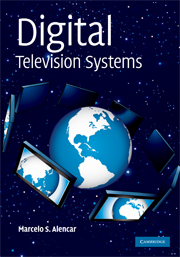Book contents
- Frontmatter
- Contents
- List of figures
- List of tables
- List of contributors
- Preface
- Acknowledgments
- 1 Fundamentals of digital television
- 2 Audio and video coding
- 3 Fundamentals and standards of video and audio compression
- 4 Channel coding for digital television
- 5 Digital and analog transmission systems
- 6 Advanced Television Systems Committee standard (ATSC)
- 7 Digital video broadcasting (DVB)
- 8 International Services Digital Broadcasting for Terrestrial Television Broadcasting (ISDB)
- 9 International System for Digital Television (ISDTV)
- 10 Digital terrestrial television multimedia broadcasting (DTMB)
- Appendix A Evolution of television standards
- Appendix B Signal analysis
- Appendix C Random signals and noise
- Glossary
- References
- Index
1 - Fundamentals of digital television
Published online by Cambridge University Press: 28 January 2010
- Frontmatter
- Contents
- List of figures
- List of tables
- List of contributors
- Preface
- Acknowledgments
- 1 Fundamentals of digital television
- 2 Audio and video coding
- 3 Fundamentals and standards of video and audio compression
- 4 Channel coding for digital television
- 5 Digital and analog transmission systems
- 6 Advanced Television Systems Committee standard (ATSC)
- 7 Digital video broadcasting (DVB)
- 8 International Services Digital Broadcasting for Terrestrial Television Broadcasting (ISDB)
- 9 International System for Digital Television (ISDTV)
- 10 Digital terrestrial television multimedia broadcasting (DTMB)
- Appendix A Evolution of television standards
- Appendix B Signal analysis
- Appendix C Random signals and noise
- Glossary
- References
- Index
Summary
Digital television
Digital television appeared as a natural evolution of analog television. Previously, the phases that constituted the production of a TV show (shooting the scenes, editing, finalizing and storing videos), broadcasting (generating the video composite, modulation, amplification, radio transmitting) and reception (the capture of the signal by the antenna, the demodulation of the television set receiver and the presentation of the image and sound to the viewer) of the signal by the user were all analog, i.e. the signals that represented the image and the sound generated in the studio were all analog, as well as the signals transmitted tothe TV receiver (Carvalho, 2006).
Nowadays, the information is generated digitally in the studio. These signals are converted into analog signals and transmitted to analog television receivers. With digital television, all of the processes are digital; thus the image, the sound and all the additional information are generated, transmitted and received as digital signals. This gives the best definition of image and sound: the image is wider than the original one (panoramic screen), with a higher degree of resolution (high resolution) and stereo sound (Graciosa, 2006, Zuffo, 2006). A digital television system is made up of a set of standards, as presented in Figure 1.1, which identifies the basic components: video and audio represent the services that are essential to the broadcasting of digital television; interactivity and the new services (e-commerce, Internet access) are added to the system by the middleware (Herbster et al., 2005). These new services, introduced by digital television, originated from data transmission with video and audio.
- Type
- Chapter
- Information
- Digital Television Systems , pp. 1 - 24Publisher: Cambridge University PressPrint publication year: 2009
- 1
- Cited by



